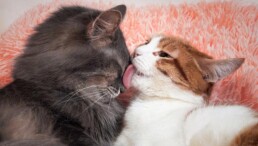The ultimate frontier of cat allergy

There are many people who suffer from allergies caused by the cat. There are about 7.3 million specimens in Italian families, thus being more widespread than the dog.
This pet much loved since ancient times for some people can be cause of allergies, triggered by specific molecules synthesized by the cat itself, and now the last frontier of allergy to cats has a name: Fel d1.
Fel d1 represents the main allergen of the cat
It is a glycoprotein secreted by the sebaceous glands of the cat, but also by salivary, lacrimal and anal glands.
During the normal activity of licking the thick coat, the cat distributes the allergen throughout the body, thus contaminating the home environment where it lives through normal hair loss. To date, the physiological function of the Fel d1 protein in the cat is not yet fully known, but similar proteins, which are present in other animals, bind sexual hormones: therefore it seems that they may be involved in the transport of pheromones or hormones in general.
Therefore, in allergic people the triggering cause is not represented by the cat’s fur, but in reality by the Fel d1 antigen present on its surface.
The reduced molecular size of this allergen drives its spreading through air, thus settling in the environment or inhaled by Man; its capacity to spread is further supported by its power of adhesion to domestic surfaces, furnishings and clothing.
Finally, this allergen last in the environment for a long time, where it can be found even in the absence of the animal itself, after several weeks.
Are there predisposing factors in the cat?
Many scientific studies were carried out to check the possible correlations between the cat features and the production of the Fel d1.
The results excluded the presence of factors related to the conformation of the hair, but proved a significant correlations related to the sex of the cat. In fact, males and unsterilised specimens seem to produce higher quantities of the Fel d1 antigen than females and sterilized cats. On the other hand, it is necessary to dispel the myth that there are cats without this antigen and therefore absolutely hypoallergenic, because the antigen is present in all cats in varying proportions. Although there are genetic and physiological differences between the various breeds, none is excluded and can therefore be considered absolutely without an allergising power.
The prevalence in men
According to a global estimate, one in five people suffer from cat allergy with more or less serious effects and in almost all cases the allergy is caused by the Fel d1 antigen, although it is not the only one since many others are recognized.
The most frequent symptoms are conjunctivitis, itching, rhinitis up to severe forms of asthma and anaphylaxis.
Developments in research
Medicine is thoroughly studying the possible actions of different molecules for the treatment of symptoms in man.
A specific Allergen Immunotherapy is currently available, which consists of long-term administration of the allergen extract, stimulating the normal desensitizing property of the immune system. The purpose of this therapy is therefore to reduce the symptomatology of the disease and at the same time increase the immune system tolerance of the allergen.
Possible future developments are the creation of vaccines for both Man and cat to fight and block the action of the Fel d1 antigen, thus cancelling its allergenic power.
Share
Related posts
Cats and hairball: there is never one without the other
Cause You can get hypnotized by the almost maniac self-care of…
Overweight and obesity in dogs and cats
Sometimes we need to lose weight put on because of feasting at…

